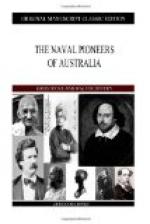They sailed on March 8th, 1801, and were surveying until May 2nd, when Grant sums up the work done in these words:—
“We have now gained a complete survey of the coast from Western Point to Wilson’s Promontory, with the situation of the different islands of the same, and ascertained the latitudes of the same, which from our different observations we have been able to do sufficiently correct.... These points being ascertained so far as lays in our power, I judge it most prudent to make the best of our way to port, keeping the shore well in sight to observe every particular hitherto unknown.”
The portions left out in this extract refer to the latitudes and longitudes, which are so correctly given that the only ascertainable difference between them and the figures in a recent addition of Norrie is in the case of Wilson’s Promontory, which Grant says is [Sidenote: 1801] in longitude between 146 deg. 25’ and 146 deg. 14’, and Norrie’s table gives us 146 deg. 25’ 37”.
On the return of the little vessel, she took part in an interesting ceremony, which the following proclamation by Governor King, dated May 29th, best describes:—
“Thursday next being the anniversary of His Majesty’s birth, will be observed as a holyday. The present Union will be hoisted at sunrise. At a quarter before nine the New South Wales Corps and Association to be under arms, when the Royal Proclamation for the Union between Great Britain and Ireland will be publicly read by the Provost-Marshall, and on the New Union flag being displayed at Dawes Point and on board His Majesty’s armed vessel Lady Nelson the military will fire three rounds, which the batteries will take up, beginning at the main guard, Bennilong and Dawes Points, at the Windmill Hills, and at the barracks. When finished, His Majesty’s armed vessel the Lady Nelson will fire 21 guns, man ship, and cheer. At noon the salute will be repeated from the batteries, New South Wales Corps and Association will fire three rounds, and at one o’clock the Lady Nelson will fire 21 guns in honour of His Majesty’s birthday. The Governor will be ready to receive the compliments of the officers, civil and military, on those happy occasions, at half-past one o’clock.”
King had a high opinion of Grant as a seaman, but he considered him an unscientific man, not suitable for surveying, and wrote to England to that effect. Grant himself confirms this in a letter asking to go home, as from the “little knowledge I have of surveying, ... where I may be enabled to be more serviceable to my country.” His faith in sliding keels had been somewhat shaken by this time, and he complained that he could not claw his vessel off a lee shore, and so Flinders found, when Grant with the Lady Nelson kept him company along the Barrier Reef when the Investigator was surveying that part of the coast. The Nelson had been ordered




